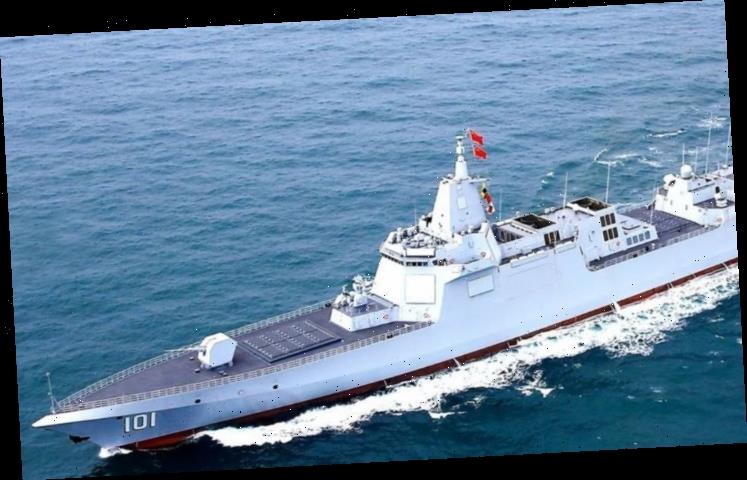CHINA have unveiled their new deadly destroyer warship that can shoot down ballistic nuke missiles and satellites – redefining water-based warfare and putting the US on high alert.
Chinese aircraft carrier Liaoning was accompanied by the new state-of-the-art vessel, a Type 055 destroyer -which discreetly made its world debut during a training exercise near Taiwan.
Despite being substantially smaller than US warships spotted in nearby waters, the Type 055 dwarfs its American opponent in stealth and surreptitiousness.
It is the world's second-most powerful destroyer, behind the US Navy's Zumwalt-class.
At around 180 metres long and 22 metres wide, the capabilities of the Type 055 are impressive to say the least.
It has 112 vertical launch missile cells, which can launch a combination of surface-to-air missiles, anti-ship missiles, land-attack missiles and anti-submarine missiles.
This means it can deploy projectiles to intercept incoming attacks, thanks to its dual-band radar system.
It boasts four flat planar phased arrays embedded in the trailblazing watercraft, accompanied by four smaller panels which are mounted on the integrated mast.
The advanced systems used even reduce radar and infrared signatures left behind by the superstructure, allowing it to covertly cruise the waters.
Rigged out with a helicopter deck and a stern hangar, capable of accommodating up to two helicopters, it enables China to prepare for attacks from every angle.
Weighing in at around 13,000-tons at full load displacement, the sturdy ship is set to house a string of new weapons that are currently still under development.
The destroyer is armed with YJ-18A anti-ship cruise missiles (ASCMs) and YJ-100 long-range ASCMs, as well as HQ-10 short-range surface to air missiles (SAMs) and HHQ-9B long-range SAMs.
As well as this, a H/PJ-38 130mm dual-purpose naval gun is fitted on the bow deck.
The extensive artillery also enables close-point defence against low-flying fixed rotary-wing aircraft, boats and small craft, coastal targets and floating mines are also on the boat.
Using the latest decoy technology, the gas-turbine powered Destroyer can even prevail in electronic warfare, with EW jammers, Type 726-4 decoy launchers, electronic support measures (ESM) system and electronic countermeasures (ECM) system.
Senior Asia Pacific defence analyst Gabriel Dominguez told the South China Morning Post, "Besides bolstering the combat capabilities of the carrier groups, the Type 055 can enhance the country’s deterrence and power projection capabilities, especially amid heightened tensions in the region over the status of Taiwan and territorial disputes in the East China and South China seas."
The destroyer was seen alongside the 55,000-ton Liaoning, which can carry up to 40 light fighters and helicopters, is reportedly fitted with an electromagnetic aircraft launch system, and can carry 2,500t of aviation fuel.
Boasting a Flying Leopard 3000 Naval (FL-3000N) missile system and Type 1030 close-in weapon system (CIWS), it's never-ending abilities has shook international naval authorities.
It is also armed with anti-submarine warfare equipment, supported by rocket launchers, and uses advanced systems that can engage subsonic and supersonic targets within the range of nine kilometres and six kilometres.
Above deck, it is kitted out with a three-dimensional air and surface search radar and four multifunctional active phased array radar panels, according to a Naval Technology analysis.
The revelation of the militarised maritime Destroyer as it sailed through a "choke point" south of Japan this weekend has only exacerbated tensions between the US and China.
As the vessel and five escort ships sailed towards the Pacific Ocean, the USS Theodore Roosevelt and two accompanying vessels headed through Malacca Strait, past Singapore, and into the South China Sea.
The Chinese Navy claimed their carrier group were merely carrying out "routine" drills in the waters, which they have said will become a regular occurrence, mirroring the US Navy's explanation that it was conducting routine operations in the area.
Despite complaints from Taiwan regarding the increased military activity near the island in recent months, China have evaded offering a sincere explanation.
It is feared they are accelerating attempts to claim sovereignty over Taiwan to intercept their allied relationship with the US, who provide the democratically run island weapons and other support.
Instead they maintain their aim is merely to "enhance its capability to safeguard national sovereignty, safety and development interests".
Territory in the South China Sea has continued to cause trouble between the two countries.
China have physically increased the size of existing islands and created more in a bid to reclaim the land, after the US, the Philippines, and Vietnam challenged them on their reluctance to share the resource-rich enclave.
They have become particularly frustrated with US interference, who maintain they are free to navigate, as China claimed foreign militaries are not able to conduct intelligence-gathering activities in the waters.
Source: Read Full Article






